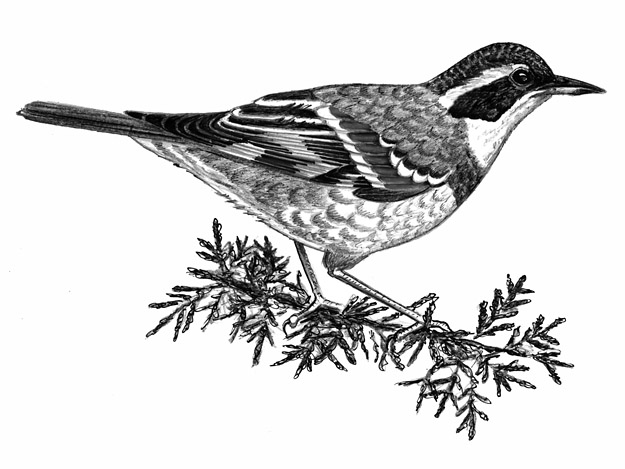
Dear Bird Folks,
A friend, who lives in my town, told me that she has a Varied Thrush coming to her yard. I went over to see it, but the bird wasn’t there. When I got home I read that Varied Thrushes are West Coast birds and now I’m not sure if my friend was mistaken. Should I believe her?
Diane, Centerville, MA
Don’t believer her, Diane,
I never believe anything people from Centerville tell me. Centervillites have lived their entire lives in the shadow of uppity-up Osterville and they will do just about anything to turn the spotlight onto their subdued little village. Heck, just a few weeks ago they forced a trained turkey to attack a mail truck in a feeble attempt to grab a bit of attention. And now we are expected to believe that one of the most colorful birds in the thrush family has flown across the entire continent of North America just to eat at a feeder in Centerville. I don’t think so. Tell your friend “nice try.” And one more thing…wait, I have a call coming in. Oops.
After receiving a call from a birder pal of mine, it seems your friend is actually telling the truth. There really has been a Varied Thrush in Centerville. Well, waddya know? Boy, is my face red. Is it getting hot in here? And what is even more awkward, for the second time in two weeks I’m writing about a western bird. I guess that’s okay. It’s still winter in these parts and the local birds have started to become boring. Maybe some talk about colorful western birds will make this winter less dreary. Oh, if it were only that easy.
Thrushes are a rather diverse family of birds. The spotted thrushes, like the Wood Thrush and the Hermit Thrush, are basically on the plain side, like Centerville. But this family also contains several visually striking birds. Believe it or not, our pal the Eastern Bluebird is also a thrush and so is the ubiquitous American Robin. The Varied Thrush of the West Coast easily falls into the “striking” category. It truly is a handsome bird. It looks like a cross between a robin and a Baltimore Oriole. Varied Thrushes are chubby, black and orange ground-feeding birds, just like robins. However, their orange coloring is less brick orange and more brilliant orange, like that of an oriole. In addition, the orange isn’t confined to the bird’s breast and belly; the black and orange are mixed throughout the bird, as if it was created in some kind of avian spin art machine.
Few people in the East have ever seen one of these birds, as it really is a bird of the West…and I’m not talking West Barnstable, either. The breeding grounds of the Varied Thrush run from Alaska, down along the coast to the northern part of California. This bird loves the West and rarely breeds much further east than Idaho (which is the state next to Washington and Oregon, in case you slept through your high school geography class). Its habitat of choice is thick, conifer forests. It also likes the surroundings to be moist and damp, the damper the better. (This bird clearly doesn’t have arthritis.) And even though it loves the forest, it doesn’t spend all day sitting in trees. Varied Thrushes are often found on the ground looking for worms and insects. When foraging on the ground, the bird has an unusual feeding behavior. It typically takes a few steps forward, flips over the leaf litter, and then jumps straight back and stares at the ground. After searching for exposed prey it moves forward again, jumps back and stares again. This jumping and staring ritual is repeated over and over, making the bird look like a nearsighted line dancer.
Why would a forest loving thrush of coastal North America travel 3,000 miles to come to Centerville? Did it want to meet the crazy turkey that went postal on the mail truck? That’s a good reason, but it turns out that Varied Thrushes regularly make unexplained long distance migrations. Every few years one of these birds appears somewhere in New England. Years ago a customer in Truro (MA) had a Varied Thrush spend the winter eating in his window feeder. I told the guy the only reason he had such a cool bird was because he was buying his birdseed from me. (Why not? He couldn’t prove me wrong.) Scientists, on the other hand, aren’t sure why these transcontinental migrations occur. One theory has to do with snowfall. When the western mountains become snowbound the birds are forced to take a road trip in search of greener pastures. Some birds enjoy traveling so much that they don’t stop until they hit the Atlantic Ocean. In 1982, one bird didn’t stop. It continued on, somehow managing to cross the entire Atlantic and ended up in England. (England must be a dream come true for a bird that loves things moist and damp.) The thrush eventually settled in the tiny town of Nanquidno, which is the British equivalent of Centerville.
I hope you get to see the Varied Thrush, Diane. They really are attractive birds. However, they are aggressive birds, too. They have been known to keep all other birds away from a feeder and even out of an entire yard. If that happens to your friend, just have her hire the whacky turkey. That tom will send the thrush back to the West Coast quicker than you can say Nanquidno.